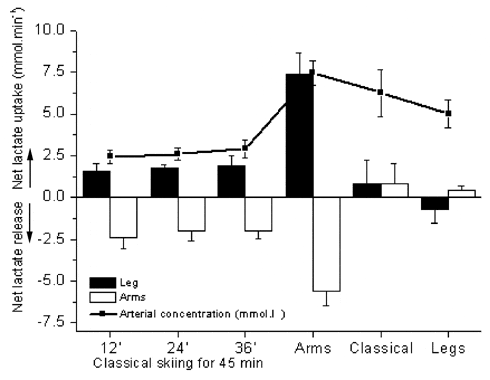Skeletal muscle has been shown to be an important site of lactate production and utilization during exercise. The rate of lactate utilization is suggested to be related to lactate delivery and activity of the muscle (Stanley et al. 1986). This study investigated limb lactate metabolism engaging arms and legs in cross-country skiing. Seven male elite Swedish skiers (age 24 ± 1.4 years (mean ± S.E.M.), mass 74 ± 2.1 kg) with a VO2,max of 5.2 ± 0.1 l min-1 participated in this study, which was approved by the Karolinska Institute Ethical Committee, Sweden. Blood samples were obtained from a femoral vein and artery and subclavian vein with the tip of the catheter positioned < 10 cm distal from the junction with the jugular vein. Blood flow was measured with the thermodilution method. After catherization a primed constant infusion of [1-13C] lactate was started for 3 h at rest and the infusion was increased 4-fold during exercise, consisting of 45 min classical style skiing followed by 5 min of arm pooling, 5 min classical skiing and 5 min leg skiing at approximately 75 % VO2,max under all exercise conditions. Blood samples were taken and blood flows measured after 12, 24 and 36 min of classical skiing and at the end of the 5 min of arm, classical and leg skiing.
Arterial lactate concentration was around 2.5 mmol l-1 during the 45 min of classical skiing engaging both arms and legs in the exercise, but increased 3-fold after 5 min of arm poling and declined when switched to classical and leg skiing (Fig. 1). A net lactate uptake by the leg and a net lactate release by the arm of similar magnitude were observed during the 45 min of classical skiing. The tracer calculated lactate release was approximately 3.5 mmol min-1 for both the leg and arm, but lactate uptake by the leg was substantially higher resulting in a net lactate uptake. During arm poling the increase in net leg lactate release was mainly caused by an increased lactate uptake, whereas the increase in arm net lactate release was mainly caused by an increase in lactate release. The lactate taken up by leg and arm during exercise was found to be completely oxidized. Legs and arms release and uptake could account for 80-100 % of whole body lactate appearance and disappearance. The present study clearly shows that skeletal muscle is the prime tissue of not only lactate production but also clearance.

